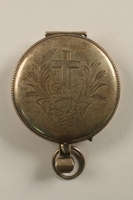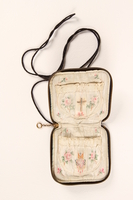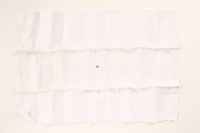Overview
- Description
- Contains photographs illustrating Edward C. Henry's experiences during and after World War II as a Catholic chaplain in the United States Army. Includes black-and-white images depicting his army unit as well as Signal Corps imagery of Buchenwald and Dachau concentration camps shortly after liberation. Also includes numerous images of bomb-damaged towns and cathedrals in France.
- Credit Line
- United States Holocaust Memorial Museum Collection, Gift of the Estate of Edward Henry
- Collection Creator
- Edward C. Henry
- Biography
-
Edward C. Henry was born in 1912 in Trenton, New Jersey, the youngest of 10 children. He graduated from Our Lady of Angels Seminary at Niagara University in New York. He was ordained to the priesthood on March 13, 1937. He enlisted in the United States Army and served as a chaplain in Texas, England, and France.
On August 25, 1944, Father Henry and his regiment assisted in the liberation of Paris soon after the landings in Normandy that June. In reflecting upon his service as an army chaplain, he noted that "it was hard to get used to," as soldiers "half alive would come in and you try to ease their last moments." He was one of the first American priests to say mass at the Cathedral of Notre Dame post liberation. Father Henry traveled throughout France, performing last rites, saying mass, and administering communion to the troops.
After the war, he returned to New Jersey and led three congregations prior to retiring in 1970. He died in 1999, age 87 years old.
Physical Details
- Genre/Form
- Photographs.
- Extent
-
1 folder
Rights & Restrictions
- Conditions on Access
- There are no known restrictions on access to this material.
- Conditions on Use
- To the best of the Museum's knowledge, there are no known copyright restrictions on the material(s) in this collection, or the material is in the public domain. You do not require further permission from the Museum to use this material.
Keywords & Subjects
- Corporate Name
- Dachau (Concentration camp) Buchenwald (Concentration camp)
Administrative Notes
- Holder of Originals
-
United States Holocaust Memorial Museum
- Legal Status
- Permanent Collection
- Provenance
- Donated to the United States Holocaust Memorial Museum in 2010 by John Grasser.
- Record last modified:
- 2024-01-31 14:46:04
- This page:
- https://collections.ushmm.org/search/catalog/irn43117
Download & Licensing
- See Rights and Restrictions
- Terms of Use
- This record is not digitized and cannot be downloaded online.
In-Person Research
- Request 7 Days in Advance of Visit
- Plan a Research Visit
-
Request in Shapell Center Reading Room
Bowie, MD
Contact Us
Also in Edward Henry collection
The collection consists of artifacts and photographs relating to the experiences of Edward Henry, a chaplain in the United States Army during World War II in England and France, where his unit participated in the liberation of Paris.
Date: 1944-1964

Sterling silver communion host pyx engraved with a cross, wheat, and a grape cluster used by a US Army chaplain
Object
Sterling silver, engraved altar bread host used by Father Edward Henry, a chaplain in the United States Army in Europe during World War II. A pyx is a vessel used to transport consecrated communion host. As a Catholic priest, he carried a portable Mass kit to administer last rites, to offer communion, and to perform mass for the troops. Father Henry and his unit took part in the liberation of Paris from Nazi Germany on August 25, 1944. He was one of the first American priests to hold mass in the Cathedral Notre Dame de Paris after liberation.

Sterling silver communion host pyx with the engraved monogram IHS used by a US Army chaplain
Object
Sterling silver altar bread host engraved IHS, a monogram for the name of Jesus Christ (Iesous Christos), used by Father Edward Henry, a chaplain in the United States Army in Europe during World War II. A pyx is a vessel used to transport consecrated communion host. As a Catholic priest, he carried a portable Mass kit to administer last rites, to offer communion, and to perform mass for the troops. Father Henry and his unit took part in the liberation of Paris on August 25, 1944. He was one of the first American priests to hold mass in the Cathedral Notre Dame de Paris after liberation.

Brown leather burse and sheet of prayers used by US Army chaplain
Object
Satin lined leather burse, or case, used to carry ceremonial items used for Mass by Father Edward Henry, a chaplain in the United States Army in Europe during World War II. A sheet with prayers and the Rite of Eucharistic Devotion from 1964 was later stored in the burse. As a Catholic priest, Father Henry carried a portable Mass kit to administer last rites, to offer communion, and to perform mass for the troops. His unit took part in the liberation of Paris on August 25, 1944. He was one of the first American priests to hold mass in the Cathedral Notre Dame de Paris after liberation.

Brown leather laced burse with embroidered satin pockets, a purificator, and a small cloth used by a US Army chaplain
Object
Leather burse, or case, with laced side flaps and two pockets, used to carry ceremonial items used for Mass by Father Edward Henry, a chaplain in the United States Army in Europe during World War II. As a Catholic priest, Father Henry carried a portable Mass kit to administer last rites, to offer communion, and to perform mass for the troops. He also carried a purificator, used to wipe the chalice after each use during communion, and the small cloth, which may have been used as a finger towel. A chaplain's Mass kit may include many other items, but it is adapted depending on where it may be used. Father Henry and his unit took part in the liberation of Paris on August 25, 1944. He was one of the first American priests to hold mass in the Cathedral Notre Dame de Paris after liberation.



